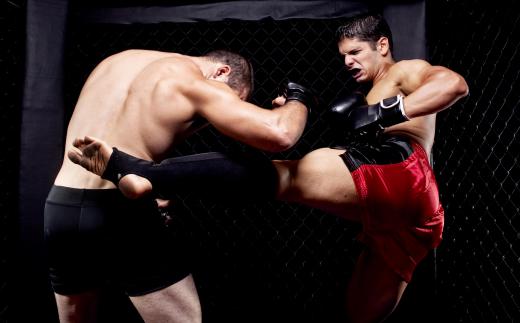At Sports&Hobbies, we're committed to delivering accurate, trustworthy information. Our expert-authored content is rigorously fact-checked and sourced from credible authorities. Discover how we uphold the highest standards in providing you with reliable knowledge.
What are the Different Karate Belt Colors?
One of the things spectators most often notice about traditional karate practitioners are their belts. With colors ranging from simple black and white to brilliant blue and red, the belts draw attention and seem to have significant meaning. This is because the karate belt’s color indicates the rank of the person wearing it. While there are no universal rules that govern which karate belt colors equal which ranks, each individual martial arts organization usually specifies an order for belt advancement.
Karate belt colors tend to progress from lightest to darkest. White is almost universally the starting color, with either red or black being the final belt. In a typical full-spectrum color progression, the belts would be white, yellow, orange, green, blue, purple, brown, and black. In Taekwondo, a common belt system is white, yellow, green, blue, red, and black. In Brazilian Jiu-Jitsu, the adult belt colors are white, blue, purple, brown, black, and red. The children’s belt colors in Brazilian Jiu-Jitsu are white, yellow, orange, and green.

Not all martial arts organizations use traditional karate belt colors, materials, or progressions. Many Chinese martial arts either use sashes to show rank or do not use any belt ranks at all. The Marine Corps Martial Arts Program (MCMAP) uses the colored belt progression of tan, gray, green, brown, and black. The American Taekwondo Association (ATA) uses many of the traditional belt colors, but puts them into a different order: white, orange, yellow, camouflage, green, purple, blue, brown, red, red-black, and black. Some mixed martial arts (MMA) programs use sweatbands worn on the ankles or wrists to denote rank instead of traditional belts.

The red and black karate belt colors can be two of the most confusing. In martial arts like Brazilian Jiu-Jitsu and some forms of Judo, the red belt represents the highest possible rank that can be achieved. In some versions of Taekwondo and Tang Soo Do, however, a red belt is attained before black belt.
Martial arts students usually get a rank number along with their belts. These numbers are part of a numeric ranking system. Such systems have many benefits, but are the most useful when comparing the ranks of martial artists from schools with different colored belt systems. Common ranking systems are Gup, Kyu, and Dan.
Prior to the rank of black belt, most martial arts schools use a numeric scale that progresses with the largest number being the lowest rank and the smallest number being the highest. These ranking systems include the Gup and Kyu systems. A beginner would be rank 10 (10th Gup) and someone about to test for their black belt would be rank 1 (1st Gup).
The Dan system is usually used once a black belt is achieved. This numeric system gives a larger number to the higher-ranking black belts. As an example, a 4th Dan would outrank a 1st Dan.
AS FEATURED ON:
AS FEATURED ON:












Discuss this Article
Post your comments